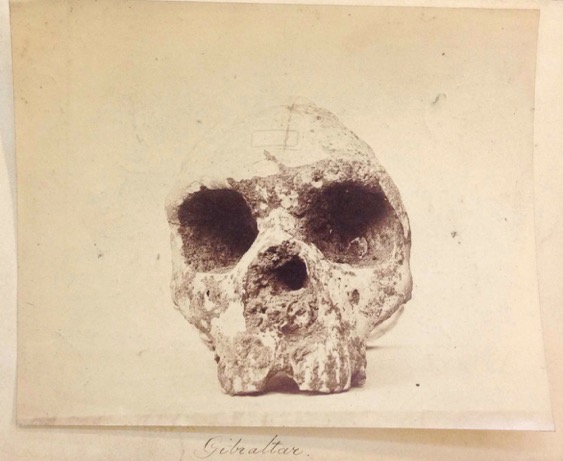The Birth of the “Neanderthals”

There it was—exactly the type of clue I was looking for. I was sitting in the library of the Royal College of Surgeons in London, an elegant, high-ceilinged room lined to the rafters with impeccably organized old books, like a frozen set piece from the 19th century. I was there to examine the papers and photographs of George Busk, a man who was once president of the college. Busk spent much of his working life at the Royal College lecturing on biology, and his papers and other materials have resided in the archives since his death in 1886.
I had been flipping through Busk’s photographs of fossils, many of which were of fragmented cave bear bones, when I came upon an image of the Gibraltar Neanderthal skull. Its large, hollow eye sockets stared up at me. Without thinking, I raised the photo toward my face for closer examination. It was then that a voice from across the room brought me back to reality, reminding me that photos must be kept on the table. These precious images are not to be held or breathed upon. I carefully placed the picture back on the table and continued to stare at it in awe.
In addition to being a surgeon, a lecturer, and a photographer of cave bear remains, Busk was the man who first introduced Neanderthals to the English-speaking world. The photograph that made me gasp had likely been taken in 1864, when Busk was most engaged in describing the skull. It captivated me not simply because it was a beautiful shot, but also because it was evidence of an important moment in the story of scholarship on Neanderthals. The Gibraltar skull had appeared as a crucial piece of evidence at precisely the moment when scientists were first attempting to discern what a Neanderthal was.
In 1856, a fossilized skull had been found in the Neander Valley in Germany, and it soon ended up in the hands of the well-regarded German anatomist Hermann Schaaffhausen. The skull looked vaguely human, with a big brain, but also different, somewhat apelike. In order to explain this peculiar skull, which became known as the “Neanderthal man,” many scientists argued that it was merely a diseased idiot who died in a cave. Others maintained that it was truly something novel—a new, humanlike creature never seen before. Busk brought the debate from Germany to the United Kingdom by translating Schaaffhausen’s scholarly paper about the fossil into English, adding his own comments to the translation. He recognized that settling the debate would require more evidence. More fossils needed to be discovered.
An answer to Busk’s call appeared almost immediately in the form of the Gibraltar skull. Originally found in 1848, the skull had been sitting in a library cupboard, collecting dust, for over a decade—until Busk’s call to action moved someone to send it to him. The fossil was strikingly similar to the Neander specimen, making it the key to settling the debate. Recognizing the fossil’s significance, Busk quickly published a paper arguing that the Neander fossil was not a “mere individual peculiarity” but instead a new type of creature whose range once stretched “from the Rhine to the Pillars of Hercules.”
The story of Busk and the Gibraltar Neanderthal zeros in on the moment when scientists first recognized that Neanderthals were something unique. The nature and meaning of the discovery—a new species perhaps, or a new variety of human—were still open. But thanks to the Gibraltar skull, scientists had determined that these creatures were not simply unhealthy humans: They were something worth paying close attention to.
This is the story that brought me to the reading room in 2014; I was hoping to learn more about this moment in history. Who sent Busk the skull? How did he go about studying it? What measurements did he take, and how did he determine the skull’s similarity to the Neander specimen? The photo gave me a glimmer of hope that I could answer these questions.
Intertwined with the 19th-century study of Neanderthals were issues of their identity and relationship to modern humans. Busk and other scientists wanted to know: Did Neanderthals have art or language? Were they humans, or were they something else? These questions likely seem familiar. Although our knowledge of Neanderthal anatomy, DNA, and behavior has grown dramatically since the 1860s, many of the questions we ask about our closest relatives are very much the same.
Like Busk, paleoanthropologists today want to know the extent of Neanderthals’ relationships and similarities with humans. They also want to know how Neanderthals lived, whether or not they had symbolic culture, and how intelligent they were. As a historian and philosopher of science, I maintain that in order to truly understand what we think we know about the Neanderthals, we must also ask, “How do we know?”
Although I don’t yet have all the answers for how Busk “knew” the Neanderthals, I have clues. This photo of the Gibraltar skull tells me more about Busk’s recognition of the skull’s importance: Photography was rare at the time, and only truly important things were photographed. A notebook he kept on his trip to Gibraltar, which I also found in his archives, illuminates his attempts to learn more about the skull. By searching through old photographs and scribbled notes, I can answer questions about how Busk and others went about “knowing” the Neanderthals. This in turn can help us appreciate how we have come to understand this sister species.
The materials buried in libraries give historians clues that help us answer questions about how we know what we think we know. Busk’s archives are a window into how he attempted to understand fossils. By studying his papers, I can view the Gibraltar skull through his eyes, and I can experience some of the wonder and fascination he must have felt when he first lifted it out of a box back in 1864.

































